Summary: Progeny of the famous and beloved Zodiac Seawolf of the 1960’s, the Zodiac Oceanaire is worthy of continuing the legacy. But will it be the last of a long and storied line? Let’s hope not!
Background
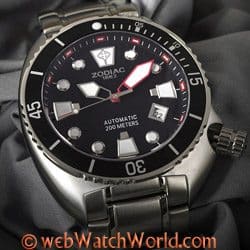 Let me start right off by saying that the Zodiac Oceanaire gets little respect, and that’s just plain wrong. Maybe it’s the dozens of Zodiac quartz watches that have flooded the market in recent years, which may have tainted the brand in the minds of some collectors. Maybe it’s plain old watch snobbery or even jealousy, or the use of an other-than-ETA movement. Or maybe it’s all of the above.
Let me start right off by saying that the Zodiac Oceanaire gets little respect, and that’s just plain wrong. Maybe it’s the dozens of Zodiac quartz watches that have flooded the market in recent years, which may have tainted the brand in the minds of some collectors. Maybe it’s plain old watch snobbery or even jealousy, or the use of an other-than-ETA movement. Or maybe it’s all of the above.
But the fact is that many watch collectors sniff when they hear the words “Zodiac” and “Oceanaire” used in the same sentence. Starting an Oceanaire thread on any watch forum is like poking a stick in a hornet’s nest. The detractors will immediately focus on the Claro-Semag CL-888 movement that powers the Oceanaire as an issue, as if they’d really know the difference between it and any other basic automatic movement.
It’s possible that like many other human biases, ignorance is to blame, because of the mysterious origins of the CL-888. It’s rumored to be a Swiss-massaged version of the Chinese Sea-Gull ST16, but so far, this heritage hasn’t been confirmed, at least to my satisfaction anyway.
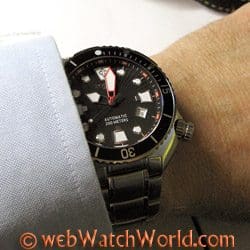 But even if it was, so what? There probably isn’t a single watch manufacturer in the world that makes all of its parts “in-house”. It’s all a matter of degrees, and whether or you believe in the myths developed by the watch manufacturers’ marketing departments.
But even if it was, so what? There probably isn’t a single watch manufacturer in the world that makes all of its parts “in-house”. It’s all a matter of degrees, and whether or you believe in the myths developed by the watch manufacturers’ marketing departments.
This is a movement which, by the way, meets Swiss regulations to carry the “Swiss Made” imprint, which should end all arguments right there. What you’ll find is that something like, oh, 99.9% of the detractors do not own an Oceanaire and probably have never seen one. But, they have their firm opinions about the watch.
Well, I’m here to tell you they’re wrong. As in Big-Time wrong. The Oceanaire is a fantastically solid piece and, at the bargain-basement prices it’s currently going for, I’ll even say it ranks up there as one of the best current watch deals to be found.
Zodiac Oceanaire Lineage
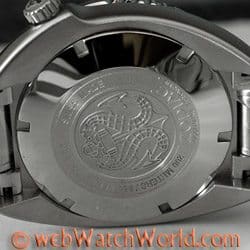 The Oceanaire is a descendent of the original Zodiac Seawolf, a favorite dive watch of the 1960’s that was popular with Navy divers and adventurers throughout the world.
The Oceanaire is a descendent of the original Zodiac Seawolf, a favorite dive watch of the 1960’s that was popular with Navy divers and adventurers throughout the world.
The Seawolf developed a good reputation with soldiers, sailors and pilots during the Vietnam war, which gave it a certain cachet as a rugged alternative to the much more expensive Omega and Rolex watches of the time. However, the brand was little known even then and the company’s ups and downs after the onslaught of the quartz era took its toll on what little brand recognition had been built.
I own an original Zodiac Seawolf, purchased brand-new in 1970 for me by my parents as a High School graduation present (actually, the deal was that I’d get the watch if I showed up at the graduation ceremony rather than go surfing that day!). So we went to a small out-of-the-way watch and jewelry shop in Manhattan, which was located near my father’s workplace. That particular shop was getting our business because the owner offered a discount to employees of the nearby company where my father was employed.
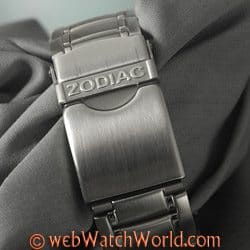 We didn’t start out looking for a Zodiac in particular, but the idea was to find a good watch. The owner of the shop, in true salesperson form, up-sold us and laid a few Zodiacs on the counter. The Seawolf was love at first sight — an impressive dive watch in those days, especially for a 17-year-old nimrod.
We didn’t start out looking for a Zodiac in particular, but the idea was to find a good watch. The owner of the shop, in true salesperson form, up-sold us and laid a few Zodiacs on the counter. The Seawolf was love at first sight — an impressive dive watch in those days, especially for a 17-year-old nimrod.
I beat the heck out of the Seawolf and wore it non-stop for many years, having it serviced only once 15 years later. It has long since been retired to my watch box, but every know and then I take it out, wind it up, charge the lume and let it rip.
One day not too long ago I became curious about the fate of the Zodiac brand, so I initiated a search to find out more. It wasn’t easy, but eventually I discovered that the company that was started in Switzerland in 1882 by a fellow named Ariste Calame (and which used the Zodiac brand name even before it was trademarked in 1908) had been acquired by Fossil.
Fossil is a publicly-traded American company who “…is a design, development, marketing and distribution company that specializes in consumer products predicated on fashion and value”, which, unfortunately, may not bode well for the further evolution of Zodiac-branded mechanical watches.
 Zodiac was once a respected watch making company. There have been several very highly regarded Zodiac watches produced over the years; besides the Seawolf, there was the Zodiac Autographic, one of the first automatic watches with power indicator; the Astrographic, with hour and minute markers that looked like they were floating in space over the watch face; the SST with its 36,000 beats per hour movement and many more. Ah, those were the glory days of Zodiac!
Zodiac was once a respected watch making company. There have been several very highly regarded Zodiac watches produced over the years; besides the Seawolf, there was the Zodiac Autographic, one of the first automatic watches with power indicator; the Astrographic, with hour and minute markers that looked like they were floating in space over the watch face; the SST with its 36,000 beats per hour movement and many more. Ah, those were the glory days of Zodiac!
However, the Zodiacs most people are familiar with are the watches of the last 20 years or so; excellent-quality, very robust cases housing mundane quartz movements. These Zodiacs are very nice watches, proven by the Super Seawolf I own that has a beautiful case, bracelet and dial that looks like it’s worth way more than the $90.00 I paid for it.
Zodiac quartz watches can be found very readily, many still with factory warranties, sold by the Metro Watch Company on eBay, the official U.S. Zodiac outlet. Zodiac watches can also be found at excellent prices in the many Fossil outlets around the world.
The Zodiac Oceanaire
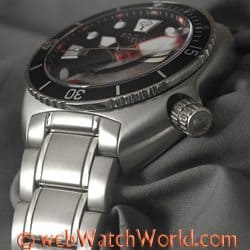 Which brings us to the Zodiac Oceanaire — the last of a line of mechanical (automatic) movement Zodiac watches. Let’s hope that Fossil will see fit to offer more mechanical Zodiacs in the future. I will give them credit though, because they have indeed been producing some very nice Zodiac quartz watches and have evolved that segment over the last few years.
Which brings us to the Zodiac Oceanaire — the last of a line of mechanical (automatic) movement Zodiac watches. Let’s hope that Fossil will see fit to offer more mechanical Zodiacs in the future. I will give them credit though, because they have indeed been producing some very nice Zodiac quartz watches and have evolved that segment over the last few years.
However, the Oceanaire seems to be slowly disappearing from the official Zodiac lineup. In January 2010, only one white-faced Oceanaire with a white rubber or silicone strap is listed for sale. The Oceanaire was made in several color variations: the black face and bracelet shown in my photos; an orange/yellow face with black rubber strap or bracelet; a black face with orange numbers and an orange rubber strap and other variations.
If you can find any Oceanaire at a bargain price — like less than $200.00, go for it! It would be the watch bargain of the decade for sure.
The Oceanaire This is a solid, massive hunk — not for everyone, that’s for sure. It takes a well-developed wrist to hold this baby, at 204 grams! But the case back is slightly curved, so the watch may fit better than you’d think.
The biggest problem for me is the bracelet, as described below in the bracelet section. My wrist diameter falls just between link lengths and I have never been able to get a “perfect” fit with the Oceanaire unfortunately, and a perfect fit is needed with a watch this big and this heavy.
But, I’ve become used to it over time and it no longer bothers me, probably because the curved back helps, along with the rounded profile over the crystal.
The Oceanaire is beautifully finished in brushed stainless steel, with a couple of polished surfaces here and there, like the dual “stripes” running the length of the bracelet.
The uni-directional bezel feels solid (a word that is used often when describing the Oceanaire) and it operates very smoothly and with 120 clicks. In fact, I’d say it’s the best-feeling bezel of any watch I own, including the very expensive Glycine Lagunare 3000 I’ll review soon.
With all that said, I’m sure the Zodiac Oceanaire isn’t for everyone. But if you’re interested in a large dive watch with “in your face” styling (nothing is subtle about the Oceanaire!) at a very reasonable price (all things considered), then the Oceanaire is for you!
Pricing
The Zodiac USA website is currently showing a single Oceanaire, a “white on white” version with a white face and white rubber strap. This must be new for 2010; last year, they had a black faced Oceanaire with orange numbers and an orange rubber strap and in 2008, they were still selling the black faced bracelet version shown here and a few others.
I wanted an Oceanaire so bad that I paid the Zodiac list price for this one, which was $495.00 in late 2008. But I’ve seen the Oceanaire sell for as little as $225.00 brand new and the Metro Watch Company eBay store occasionally sells them at auction with no reserve price, so you may get lucky and find one for less than $200.00. I honestly don’t think there’s a better automatic dive watch for that kind of money.
Also, don’t forget the lightly used versions often found for sale on watch collector websites. Some owners find that the large size of the Oceanaire is a bit too much and they’ll “flip” the watch soon after they purchased it and you could be the lucky recipient.
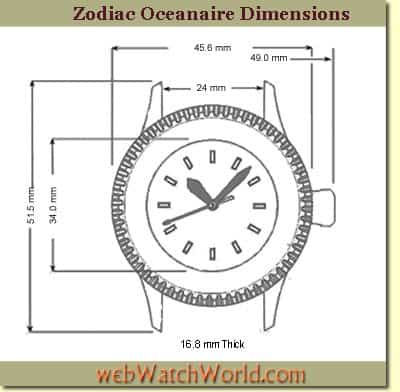
Watch Size and Weight
“Massive” is the word that comes to mind when handling the Oceanaire. The watch, with enough links removed to size for a 7.25″ wrist, weighs in at 204 grams.
The case has an unusual shape and it is rather large, but it also has a nice curvature on the back side which makes it wear more comfortably than you might think.
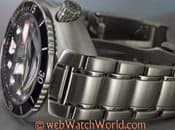 The actual width of this example, measured with a Vernier caliper, is 45.6 mm across the “9 to 3″ axis. The lug tip-to-tip distance is 51.5 mm, which actually isn’t out of line with some of the larger dive watches worn today.
The actual width of this example, measured with a Vernier caliper, is 45.6 mm across the “9 to 3″ axis. The lug tip-to-tip distance is 51.5 mm, which actually isn’t out of line with some of the larger dive watches worn today.
The Oceanaire is thick at 16.8 mm, so it might not fit under a dress shirt sleeve but I usually can wear it under a loose-fitting casual shirt. It’s best when worn with short sleeves though, to maximize the bling factor!
The visible face dimension, not counting the bezel, is 34 mm wide and the edges of the bezel are just even with the edge of the unusually-shaped watch case. The uni-directional bezel has 120 solid clicks and is smooth and easy to use. It has a lume marker at 12.
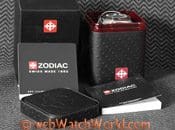 One of the most interesting features of the Oceanaire is the way the case is molded to hug the large crown.
One of the most interesting features of the Oceanaire is the way the case is molded to hug the large crown.
It takes about 4-5 rotations to screw out the very smooth feeling crown to either quick-set the date, change the hands or wind the watch. The Claro-Semag CL-888 movement has a unique feel and a sound that seems very business-like to me.
So the Zodiac Oceanaire is definitely considered a large watch and it does have a slightly unusual shape, which gives it charm but also means that it will not be for everyone. Unfortunately, the watch is so rare that you’re most likely not going to be able to walk into a local dealer for a fitment before you buy, so potential owners with less than a 7.125” wrist circumference or so may want to look elsewhere.
Lug Width
 The Oceanaire has a 24 mm lug with and the bracelet tapers down to 22 mm at the clasp. I have mixed feelings about this. It’s not the 24 mm bracelet width at the lugs that bothers me; I think this is a correct size for this watch because a 26 mm width might make it even more difficult to wear for owners at the minimum wrist circumference.
The Oceanaire has a 24 mm lug with and the bracelet tapers down to 22 mm at the clasp. I have mixed feelings about this. It’s not the 24 mm bracelet width at the lugs that bothers me; I think this is a correct size for this watch because a 26 mm width might make it even more difficult to wear for owners at the minimum wrist circumference.
The feature that I wonder about most is the 22 mm bracelet width at the clasp. I would probably rather have a 24 mm bracelet width all the way around, as I think this might better balance the 150+ grams of watch case on the hand.
Bracelet
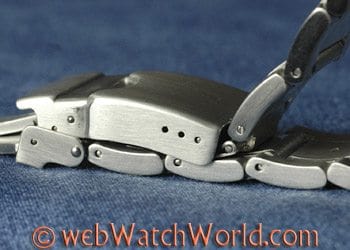 Width questions aside, the Oceanaire bracelet is a very nice match for this showy watch. Solid brushed stainless steel links with the double run of polished offsets adds some flourish without overdoing it. The big bracelet would probably look too plain if it was all brushed stainless, so the polished inserts are just about the perfect touch.
Width questions aside, the Oceanaire bracelet is a very nice match for this showy watch. Solid brushed stainless steel links with the double run of polished offsets adds some flourish without overdoing it. The big bracelet would probably look too plain if it was all brushed stainless, so the polished inserts are just about the perfect touch.
The bracelet fits with integrated links between the lugs, so there is no space that can be seen between the springbar and the watch case. The links are tapered; that is, each link counting down towards the clasp is narrower than the one before it, down to the last three or so links just at the clasp.
My wrist measures about 7.25″ (18.4 cm) which causes a situation where adding one link makes the bracelet too big, while taking out a link makes it too small. Normally, the clasp will have 4 micro-adjustment positions which equals the length of one link, so it can be adjusted perfectly. But the Oceanaire bracelet has only 3 micro-adjustment holes, leaving it still just too loose or just a little too tight.
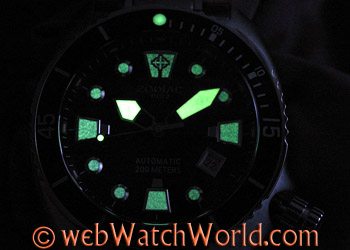 I have even tried swapping out different links, hoping I could find some combination of taper that would work, but it’s not to be.
I have even tried swapping out different links, hoping I could find some combination of taper that would work, but it’s not to be.
So I have left the bracelet on the tight side, because a watch this big and this heavy should not be floating around on one’s wrist. It took me a while to get used to it, because a human wrist will swell during the day and sometimes the Oceanaire feels just a little too tight for comfort. In fact, some days I’ll end up with a beautiful wrist imprint of the Zodiac sea horses and diver that are engraved on the back!
As mentioned above, the Oceanaire is also available with a fitted rubber or silicone strap (I’m unsure which), but I have never tried one. If the clasp holes line up just right, the stretchiness of the rubber may help to hold the watch tighter to the wrist while still remaining comfortable. I’m a big fan of stretchy rubber watch straps for just that reason.
Even though an accessory strap can be added to the Oceanaire, the watch does not look right in my opinion, especially with the big gap that then shows between the springbar and the case. Watches with oval shaped or “cushion” cases are more difficult to fit with accessory straps because they just look out of proportion for some reason.
Setting the Oceanaire and Accuracy
The CL-888 movement “hacks”; that is, when the crown is unscrewed and pulled out, the seconds hand will stop and the watch can be synchronized with the “atomic” clock.
It’s slightly difficult to unscrew the crown on the Oceanaire, due to the recess built in to the watch case, designed to protect the crown from damage. The fine threads give the crown a solid feel as it’s being unscrewed. Pull it out one stop to wind it; the next to quick-set the date (anti-clockwise) and pull it out all the way to set the hour and minute hands.
The feel of the stops is a bit muted, so I often have to push the crown back in and then pull it out again to feel the stop positions. I’m not sure if that is an issue with my Oceanaire only or a feature of the movement. I think the thick and grippy O-ring gasket has something to do with the muted feel also. The crown stem has very slight “wobbly” play when pulled out all the way.
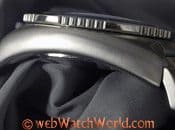 The date will quickly and firmly snap to the next day at midnight and there is no discernible play in the hands when the crown is turned, which gives the movement a very solid and quality feel.
The date will quickly and firmly snap to the next day at midnight and there is no discernible play in the hands when the crown is turned, which gives the movement a very solid and quality feel.
The big sword-shaped hands allow a fine setting to increments of a minute if desired and the somewhat huge hands have an interesting appeal as they are swung around the face with the crown.
I have experienced no accuracy problems at all with this Oceanaire; it has been extremely accurate right out of the box and needed no break-in time. It runs within +2-3 seconds at most per day and is very consistent. This seems to be within COSC chronometer accuracy standards, although the watch obviously does not have a COSC certificate. The outstanding accuracy is another plus for the CL-888.
It’s interesting to note that the Oceanaire is nearly completely silent. I can press it as close as I can get it to my ear and I hear nothing as it works away. I believe it beats at 21,600 BPH, or 6 beats per second.
Readability and Face
The slightly curved crystal of the Oceanaire can cause some reflections, as seen in the video. It was difficult to video the watch without a lot of reflections from the lighting.
That, along with the big white hands and the large surface area of white lume, can make the Oceanaire slightly difficult to read. But this could be said for many watches other than those designed for quick, accurate readings, like the so-called pilot’s watches. I have a few that are very easy to read with a lighting-quick glance, such as the Glycine Combat I’ll review at some point in the future.
But, I have seen much worse than the Oceanaire, and considering that this watch has such a good wrist “presence”, the readability isn’t bad.
The date window takes the 4:00 position and is nicely integrated into the design. The date window has a thin chrome surround to match the other indices on the watch face.
The black face with red details on this Oceanaire version is very nice. There’s a very subtle sunburst pattern that can be seen, curiously enough, in some frames of the video. The sunburst is much more noticeable on the lighter-colored versions of the Oceanaire, especially the orange color.
Lume
The Oceanaire has excellent lume, which is to be expected with the big hands and lume-filled indices (see photo in the second section above). The lume is also very evenly applied and it looks just like paint or a solid coating. I’m not sure what brand lume is used, but it works well.
Conclusion
The Zodiac Oceanaire is an unusual, somewhat rare, large dive watch with lots of wrist presence. This is a watch that will definitely get comments. It is very, very solid and the quality is outstanding and well worth the money, in my opinion.
While it may not fit every wrist, it is different enough and it has the quality to deserve a much better standing in the watch collecting community. But who cares what the Watch Idiot Savants (WIS) think — if you like the looks of the Oceanaire and it fits, buy it and most likely you’ll be a Zodiac fan forever!
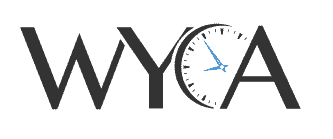
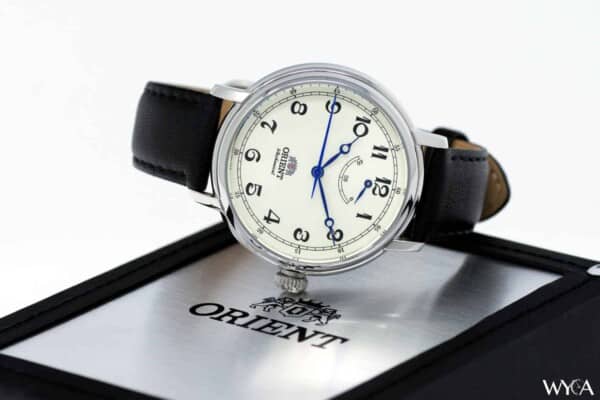
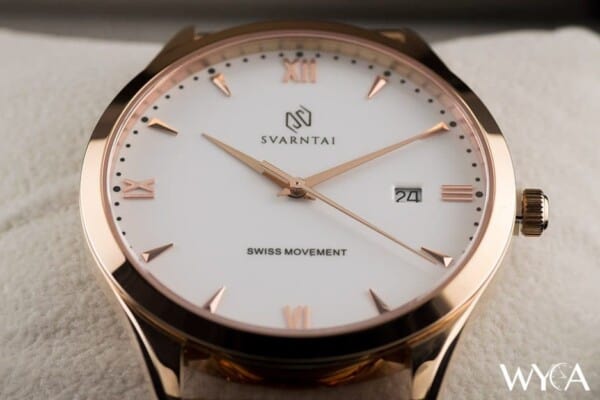
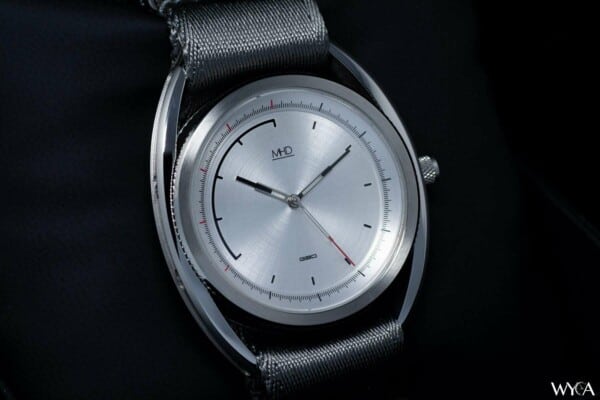
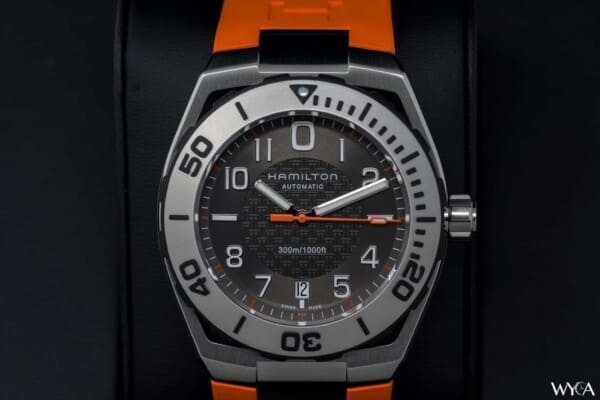

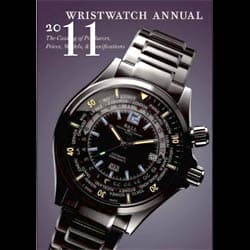
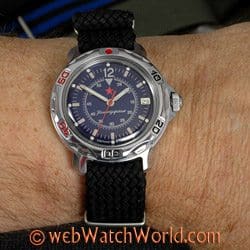
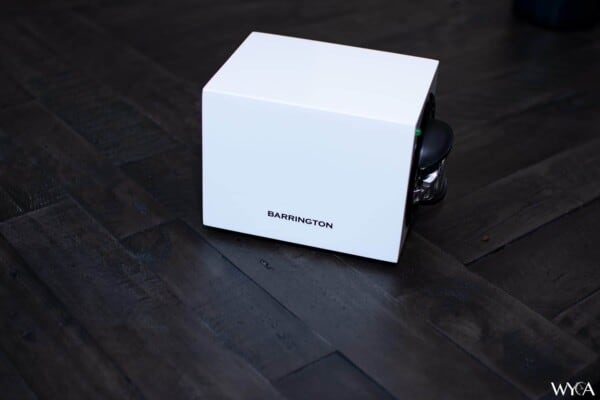
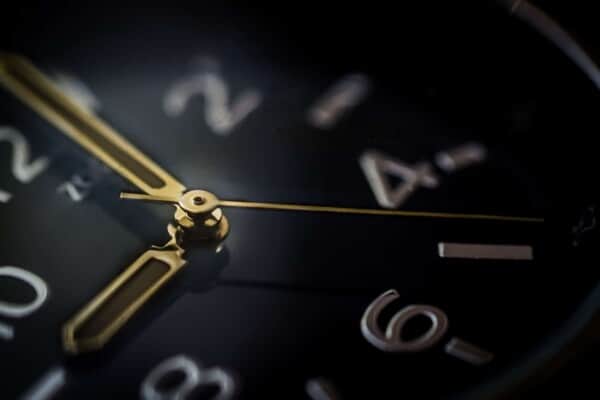
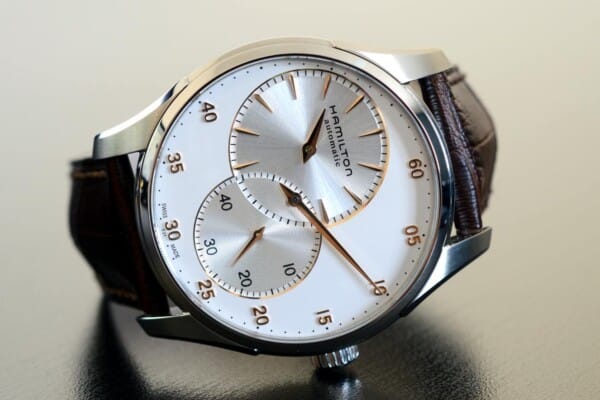
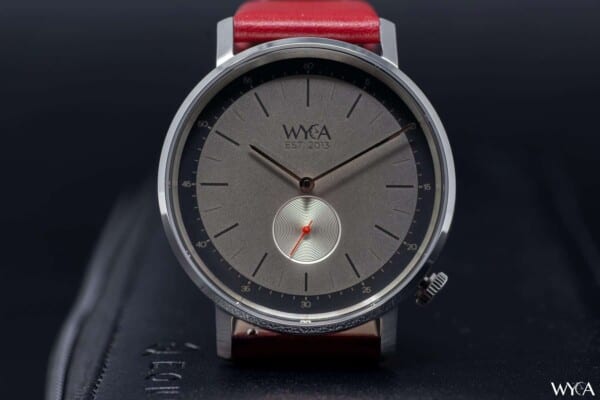
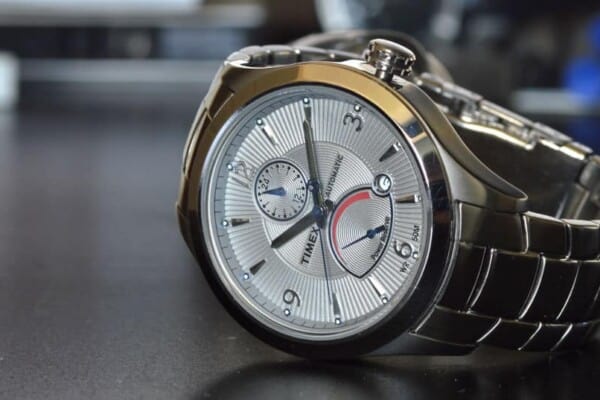
Thanks I just bought an Oceanaire and love it
Glad to hear it! Enjoy 🙂
I’ve had my Oceanaire since about 2008 – love the watch. The 3rd link from the case on the bracelet broke. It’s the last link that cannot be replaced. Any ideas on how to fix or replace? All I’ve found online are the rubber straps (24mm) but no bracelets for sale. I contacted Zodiac/Fossil, but they want me to send it in, and it’s a minimum $38 charge (Labor and return shipping) just for them to look at it, the who knows how much to repair/replace. Any suggestions?
I own the bracelet yellow/blue one version. It’s a fantastic watch. Thanks! for the comprehensive review.
I had the yellow face version and overall found it very comfortable on the wrist. I did sell it in the end because I found the lume to be very lacking for a dive watch. Spoiled by Seiko